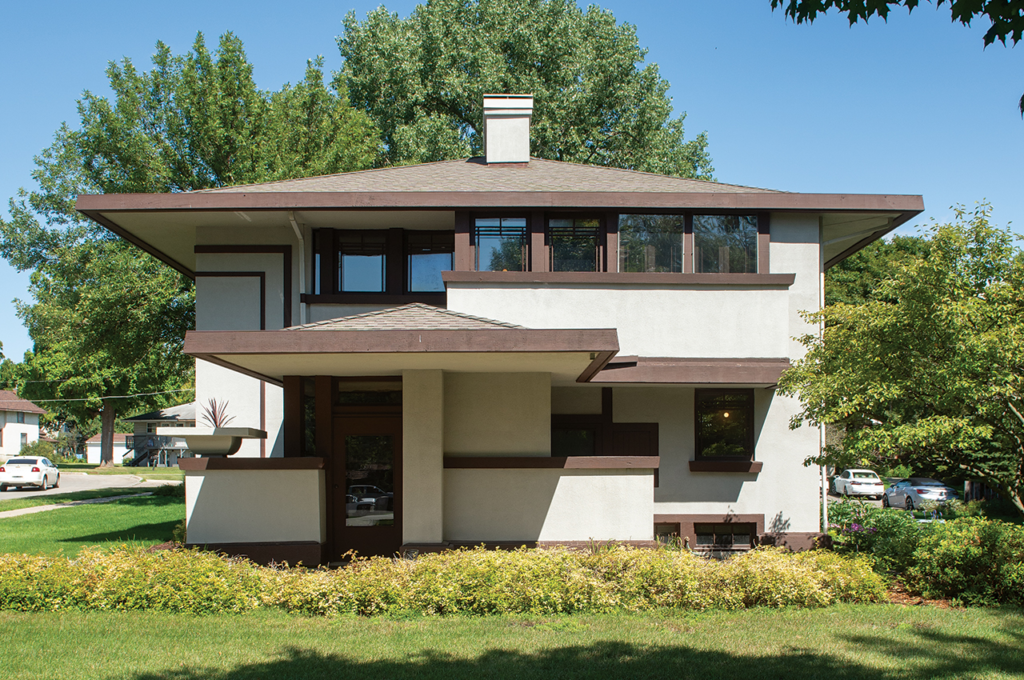
Table of Contents
Defining the Prairie School in Architecture
The Prairie School of architecture emerged in the late 19th and early 20th centuries as a response to the prevalent Victorian architectural styles. Led by renowned architects such as Frank Lloyd Wright, Louis Sullivan, and Walter Burley Griffin, this movement aimed to create a uniquely American style that was in harmony with nature. The prairie landscape served as a constant source of inspiration for these architects, who sought to integrate buildings seamlessly into the surrounding environment.
One of the defining features of Prairie School architecture is its emphasis on horizontal lines and an open floor plan. Unlike the verticality and compartmentalization found in Victorian architecture, prairie buildings were characterized by their low-pitched roofs, long stretches of windows, and interconnected spaces that flowed effortlessly from one room to another. This design philosophy aimed to create a sense of freedom and connection with nature by allowing natural light to flood into the interiors while also providing unobstructed views of the prairie beyond.
Furthermore, many Prairie School buildings showcased intricate detailing inspired by nature. From organic motifs such as leaves or flowers incorporated into decorative elements like stained glass windows or exterior designs carved into stone facades—these details added depth and visual interest while paying homage to the prairie’s beauty. Overall, Prairie School architecture stands out for its ability to blend form with function harmoniously and create spaces that invite occupants to truly experience their surroundings in an intimate way.
The sweeping plains of the Midwest have long been an inspiration for artists and architects alike. But one architectural movement stands out among the rest, capturing the essence of the prairie like no other. Enter the Prairie School, a revolutionary style that emerged in the late 19th century, challenging traditional European designs and embracing a uniquely American aesthetic. Characterized by low horizontal lines, earthy materials, and harmonious integration with nature, this innovative approach to architecture not only transformed the Midwestern landscape but also laid the foundation for modern design principles that continue to influence architects around the world today.
Imagine walking through a vast open field as a gentle breeze rustles through tall grasses and golden sunlight bathes everything in its warm glow. Now imagine that same sense of tranquility translated into architectural form – that is exactly what you’ll find in the Prairie School movement. Born out of a desire to break free from ornate Victorian designs and create structures that embraced their natural surroundings, this distinctly American style embodies simplicity, harmony with nature, and an appreciation for craftsmanship. From Frank Lloyd Wright’s iconic Robie House to Marion Mahony Griffin’s stunning work at Eaglefeather on Lake Michigan, join us on a journey into this captivating world where buildings blend seamlessly with their prairie landscapes.
Origins: Frank Lloyd Wright and his influences
Frank Lloyd Wright, renowned as one of the pioneers of modern architecture, was deeply influenced by various factors that shaped his unique design philosophy. One significant influence on Wright’s work was the Japanese aesthetic and principles of design, particularly evident in his concept of organic architecture. The simplicity and harmony found in Japanese art and architecture resonated with Wright’s belief in creating structures that seamlessly blended with their natural surroundings. This is evident in many of his iconic buildings, such as the Fallingwater residence which appears to emerge naturally from its Pennsylvania setting.
Another influential factor on Frank Lloyd Wright’s architectural style was the Arts and Crafts Movement. The movement emphasized a return to craftsmanship, using traditional materials and techniques as a response against mass production during the Industrial Revolution. Wright incorporated these ideas into his designs by prioritizing handcrafted details, exposing natural materials like wood and stone, and focusing on individual craftsmanship rather than uniformity. From furniture to lighting fixtures, every aspect of a Frank Lloyd Wright building reflected this commitment to enhancing human experiences through spatial design.
While many architects have left indelible marks on the field over time, few have achieved such enduring influence as Frank Lloyd Wright. His ability to merge diverse influences ranging from Japanese aesthetics to the Arts and Crafts Movement not only set him apart but also established an entirely new architectural language known as organic or Prairie School architecture. By cultivating these influences into his designs, he created buildings that harmonized with nature in ways previously unseen and changed both American architecture and how we interact with built environments even today
Have you ever wondered how the Midwest transformed from a vast, open landscape into a hub of architectural innovation? Enter the Prairie School, a revolutionary movement that emerged in the late 19th century and forever changed the face of American architecture. Inspired by the sweeping horizons and natural beauty of the Great Plains, this distinctive style sought to harmonize buildings with their surrounding environment. In this article, we will dive deep into the origins, key characteristics, and lasting impact of the Prairie School in architecture.
Picture yourself standing on a prairie, surrounded by endless fields stretching as far as the eye can see. Now imagine an architect attempting to capture this awe-inspiring scenery in their designs – that’s precisely what led to the birth of Prairie School architecture. Breaking away from traditional European styles, architects like Frank Lloyd Wright and Louis Sullivan embarked on a mission to create buildings that celebrated America’s heartland. From horizontal lines mimicking rolling plains to organic materials evoking nature’s tranquility, join us as we explore how these visionary designers reshaped architectural history with their iconic Prairie School creations.
Characteristics of Prairie School architecture
One of the most distinctive characteristics of Prairie School architecture is its emphasis on horizontal lines. Unlike traditional architectural styles that focused on verticality, Prairie School architecture aimed to blend harmoniously with the natural landscape of the American Midwest. This can be seen in the low-pitched roofs, long overhangs, and expansive windows that are characteristic of this style. By extending outwards rather than upwards, Prairie School buildings create a sense of unity with their surroundings and evoke a feeling of openness and connection to nature.
Another defining feature of Prairie School architecture is its use of organic materials. Architects like Frank Lloyd Wright sought to create homes that were intimately connected to their natural environment, both visually and physically. As a result, they often incorporated locally-sourced materials such as wood, stone, and brick into their designs. These materials not only added warmth and texture but also helped integrate the buildings seamlessly into the prairie landscape.
Lastly, Prairie School architecture placed great importance on creating functional yet aesthetically pleasing spaces. The open floor plans commonly found in these structures allowed for fluid movement between rooms and emphasized a sense of unity within the home. Additionally, architects paid careful attention to detail by incorporating built-in furniture and designed elements that served multiple purposes – such as window seats that also functioned as storage spaces. This focus on practicality without sacrificing beauty is one of the reasons why Prairie School architecture continues to be admired today for its timeless appeal.
Key examples of Prairie School buildings
One key example of a Prairie School building is the Robie House in Chicago, designed by Frank Lloyd Wright. Completed in 1910, this iconic structure showcases many hallmark features of the Prairie School style. The low-pitched roof, horizontal lines, and integration with the surrounding landscape all contribute to the building’s harmonious relationship with its environment. The use of natural materials such as brick and stone further emphasizes Wright’s commitment to creating buildings that felt connected to their surroundings.
Another notable example is Unity Temple in Oak Park, Illinois. Designed by Frank Lloyd Wright in 1905-1908, this religious structure stands out for its bold geometric forms and innovative use of space. The temple incorporates flat roofs, overhanging eaves, and extensive window walls that create a seamless connection between the interior and exterior spaces. Additionally, Wright’s signature attention to detail can be seen in the intricate design of the leaded glass windows and decorative elements throughout the building.
These two examples highlight how Prairie School architecture goes beyond simply creating aesthetically pleasing structures – it seeks to establish a deep connection between architectural design and nature. By emphasizing horizontal lines, integrating organic materials into construction, and blurring boundaries between indoors and outdoors, these buildings embody principles rooted in both functionality and beauty. Their enduring appeal continues to captivate architects and enthusiasts alike who appreciate the unique harmony they bring to their environments while pushing architectural boundaries at the same time.
Legacy and impact of the Prairie School
The Prairie School movement in architecture, which flourished between the late 19th and early 20th centuries, had a profound and lasting impact on American design. Not only did it revolutionize the way buildings were constructed, but it also challenged conventional notions of space and aesthetics. The legacy of the Prairie School can be witnessed in countless architectural masterpieces that still stand today, showcasing its enduring influence.
One of the most significant contributions of the Prairie School was its emphasis on harmonizing buildings with their natural surroundings. By incorporating low-pitched roofs, horizontal lines, and open floor plans, architects aimed to create a seamless transition between indoor and outdoor spaces. This integration with nature not only brought a sense of serenity to these structures but also set a new standard for sustainable design practices.
Furthermore, the Prairie School’s philosophy extended beyond just physical design elements. It championed democratic ideals by promoting homes that were affordable and accessible to all social classes. In essence, this style was about creating functional living spaces that uplifted people’s spirits while fostering a sense of community cohesion. Its egalitarian approach to architecture continues to inspire contemporary designers seeking to shape inclusive environments for people from diverse backgrounds.
Overall, the legacy and impact of the Prairie School are undeniable within both historical contexts and modern architectural trends. With its visionary concepts rooted in harmony with nature and inclusivity for all, this movement shaped American architectural history forevermore. Today, as we continue to grapple with environmental issues and societal challenges surrounding accessibility in design, we
Conclusion: The enduring significance of the Prairie School.
The enduring significance of the Prairie School lies in its revolutionary approach to architectural design, which continues to inspire and influence both contemporary architects and homeowners alike. One of the key aspects that sets this architectural style apart is its emphasis on harmony with nature. The flat, horizontal lines and integration of natural materials allow Prairie-style homes to seamlessly blend into their surroundings, creating a sense of unity between the built environment and the natural world.
Another enduring aspect of the Prairie School is its focus on functionality and practicality. Unlike some other architectural styles that prioritize ornate decoration or grandeur, the Prairie School believed in designing spaces that were not only aesthetically pleasing but also functional for everyday living. Interior spaces were thoughtfully designed with an emphasis on open floor plans, large windows for ample natural light, and streamlined furniture layouts.
Finally, perhaps one of the most significant contributions of the Prairie School is its promotion of democratic design principles. Frank Lloyd Wright believed that everyone should have access to well-designed spaces, regardless of social status or wealth. This philosophy led him to create affordable housing options that embraced these principles without sacrificing quality or style. Today, this commitment to inclusivity remains relevant as architects continue to explore ways to create sustainable and accessible living spaces for all. The enduring significance of the Prairie School lies not only in its architectural forms but also in its profound impact on how we think about design in relation to our environment and society as a whole


